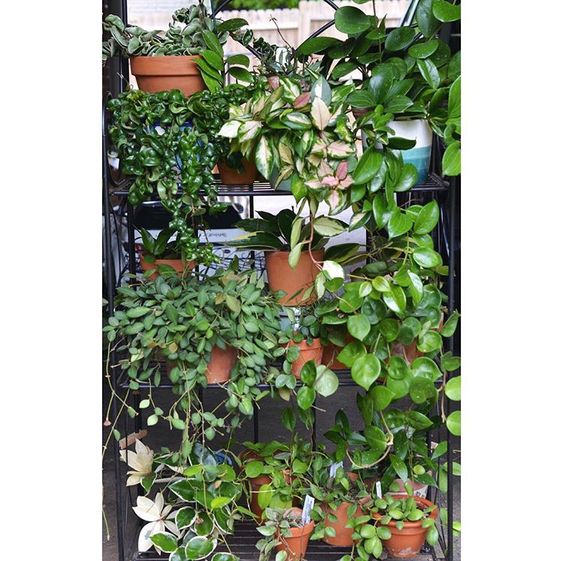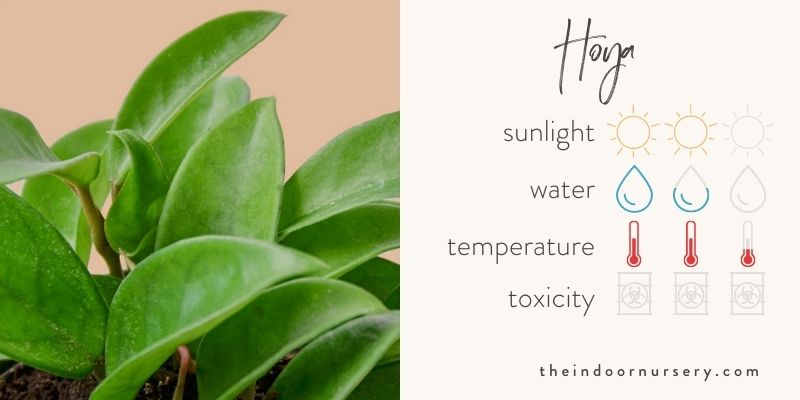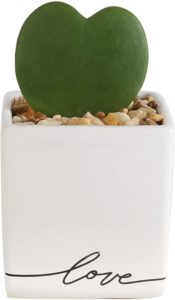plant description
If you love lush, vining houseplants but miss the occasional bloom, then you might fall head over heels for the Hoya. A diverse genus of tropical plants consisting of over 200 species, the Hoya comes in a variety of shapes and sizes, but are generally characterized by their waxy-looking vines, dark green leaves, and orb-shaped clusters of bright blooms. The wax plant is a member of the Apocynaceae, or dogbane, family. These vining plants trail or climb, depending on placement and support, and are commonly referred to as wax plants.
In the right conditions, Hoya plants produce star-shaped, thick-petaled flowers. Hoya flowers come in a variety of colors including red, white, pink, purple, and are known for their zesty, warm fragrance. The Hoya is a beautiful addition to indoor hanging baskets, descending from shelves or cabinets, or grown vertically in pots with a trellis or stake.
In general, Hoya plants are quite easy to care for. Although all Hoyas have similar characteristics and care, each variety of wax plant will have some needs specific to its species. Do a bit of research on your specific wax plant species to ensure you offer it the best environment and care.
Pet-owners and parents be-warned: as most species in the Dogbane family (Apocynum is Greek for “dog-away”), Hoya are poisonous to humans, pets and livestock upon ingestion.
plant facts
| common name | Wax Plant, Wax Flower, Wax Vine, Porcelain Flower |
| botanical name | Hoya |
| no. of species | 200-300 |
| family | Apocynaceae |
| biological life cycle | perennial |
| foliage | evergreen |
| mature size | 12-20 feet vines |
| time to maturity | varies by species – up to 5-7 years |
| origin | Asia, Polynesia and Australia |
| light conditions | bright, indirect light |
| soil type | well-draining and aerated |
| soil pH | depends on species |
| USDA Zone | 9-11 |
| toxicity | toxic to plants and people if ingested |
popular varieties
Popular Hoya types include Hoya Carnosa, Hoya Carnosa variegata (a popular variegated Hoya variety), Hoya Carnosa ‘Rubra’, Hoya Obovata, and Hoya Keysii.
how to take care of a hoya plant
light 🔆
Best light: bright, indirect light
These tropical plants thrive with a good dose of filtered, indirect light! Give your wax vine as much indirect sunlight as possible and they’ll be happy. In their natural habitat, hoyas like to climb trees or spread over rocky bluffs, soaking up light filtered through a canopy above – so consider this when finding a place for yours at home. Some varieties of Hoya do well in lower light conditions, but these plants are most likely to flower when placed in bright, indirect light.
water 💧
Water requirements: soil should dry slightly between waterings
Water your wax vine plant regularly during high growth months in the spring and summer. Allow the top layer of soil to dry out between waterings. In slower-growing months, fall and winter, water your plant just enough to keep it moist.
Most species of Hoyas are epiphytes, meaning they derive moisture and nutrients from the air and sources other than soil, so consistent waterings are important to keep this plant thriving. Over-watering can cause leaves to droop and flowers to fall off of the plant.

humidity 🌫️
As a tropical genus, porcelain flower plants flourish in higher humidity conditions. If its environment is prone to dry air, there are a few ways to add humidity to the environment including misting vines (not the flowers if they’ve bloomed) with water and placing a pebble tray or water saucer with water near the plant. Another option is using a humidifier for the space.
Although Hoya plants generally like high humidity and temperatures, some species prefer cooler and drier air. Hoya species with thicker leaves will generally be more adaptable to drier climates than varieties with more delicate leaves.
temperature 🌡️
The ideal temperature range for most Hoyas is around 60°F (16°) to 85°F (29°). Porcelain flower plants should be protected from extreme temperature changes including vents and drafty windows.

fertilizer 💩
fertilizer preferences: Use a general-purpose fertilizer for your plant during the growing season. Ensure that the soil is damp before applying, and follow the dosing instructions for your chosen fertilizer – more isn’t better! Over-dosing Hoya will cause fertilizer burn. When your porcelain flower blooms, use a phosphorous-based fertilizer to keep the plant blooming for a longer period of time.
soil 🪨
soil type: well-draining and aerated
pH level: depends on the species
If you’re familiar with the soil needs of orchids (many of which are also epiphytes), this will give you a good idea of what Hoyas are like. Hoyas prefer a coarse, airy growing medium that allows roots access to air. Blend orchid mix with a bit of compost for water retention, or make your own from scratch: one part fine bark mix (pine bark is a good option) to two parts soilless potting mix. The preferred soil pH depends on the species.
repotting 🪴
In general, the Hoya plant likes to completely fill its pot, as this environment replicates the tree hollows and rocky nooks where Hoyas like to grow in the wild. Re-pot your plant every 2 to 3 years, choosing a new pot that’s only slightly larger than the old one for a snug fit. The best time of year to re-pot your plant is during the growing season, in spring or summer, so that it can fill out its new pot before the winter.
propagation 🌱
The Hoya plant is easy to propagate from stem cuttings. Follow these steps during your plant’s most active growth period:
- Before beginning, prepare a pot with moistened growing medium and poke a hole about 2 inches deep in the middle.
- Cut about 6 inches of stem from a healthy, trailing vine just below a leaf node.
- Ensure that the bottom 2 inches of stem are free of leaves, removing any as necessary to encourage root growth here.
- Place the cutting into its new pot, and water thoroughly.
- Keep moist until roots set – about 4-6 weeks.

pruning 🌿
Hoyas are prone to growing a bit wild indoors. Pruning and deadheading will help keep the plant from growing out of control, improve its general verve, and increase its odds of blooming.
Prune your plant during the spring or summer, trimming away about ⅓ of the vines at the node, as you would when taking cuttings.
pests and diseases 🐛
pests: prone to common house pests; easily treatable with insecticidal soap or neem oil
Philodendron plants are susceptible to a myriad of common pests including aphids, mealybug, scale, and spider mites. New plant growth is especially attractive to pests. Pests should be removed immediately using insecticidal soap.
Hoya plants are susceptible to common house pests including mealybug, spider mites, scale insect, aphids, fungus gnat, and whiteflies. Treat infestations with insecticidal soap or Neem oil.
Root rot is a bigger concern however since these plants dislike sitting in water and over-watering is perhaps the most common mistake that new, eager plant owners make.
One trick to make sure you don’t over-water your potted wax plant is to purchase a small pot saucer for the size of the pot. The saucer will overflow if you over-water your Hoya by even a little bit, and you’ll pay closer attention to how much you water your plant!
plant care tips
1. As an epiphyte, the wax plant absorbs some essential nutrients through its leaves. Foliar Feeding, the process of adding foliar fertilizer to a mister and feeding a plant by spraying its foliage, is one way to increase humidity and give the Hoya a boost of nutrition at the same time.
Common Problems / FAQs:
1. Blackening leaves and stems
→ It’s possible the porcelain flower plant is not draining properly or that the roots are water-logged and have started to rot. Remove any drenched soil and soggy roots, and add fresh, well-draining soil to the bottom of the pot.
2. Root rot
→ This could be a result of over-watering or poor-draining soil. Cut back roots that are rotting as soon as possible.
3. No blooming flowers
→ If the Hoya plant is at full maturity and not blooming, it’s possible that it’s lacking light. Move the plant to a place with brighter indirect light.
Shop our recommendations
- The Best Hydroponic Tower For Indoor Gardening
- 10 Best Worm Composter Bins For Easy Homemade Compost
- The Best pH Meter For Soil
- The 6 Best Dehumidifiers For Grow Tents
- The Best Complete Indoor Hydroponic Grow System
- 5 Best Grow Light Strips For Indoor Plants
- TESTED: Aerogarden vs Click and Grow Smart Garden
- Our *hands on* MARS HYDRO TSW 2000 review (with photos)
- 7 Best Hygrometers For Indoor Plants
- The Best Coco Coir For Your Plant’s Healthiest Root System Ever



Hey, Marcia! Thanks for reading :) gosh, that's a great idea to double up on your watering globe and spike.…